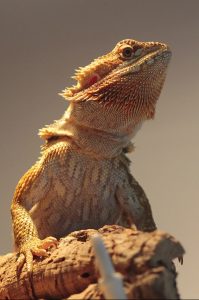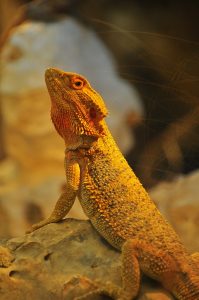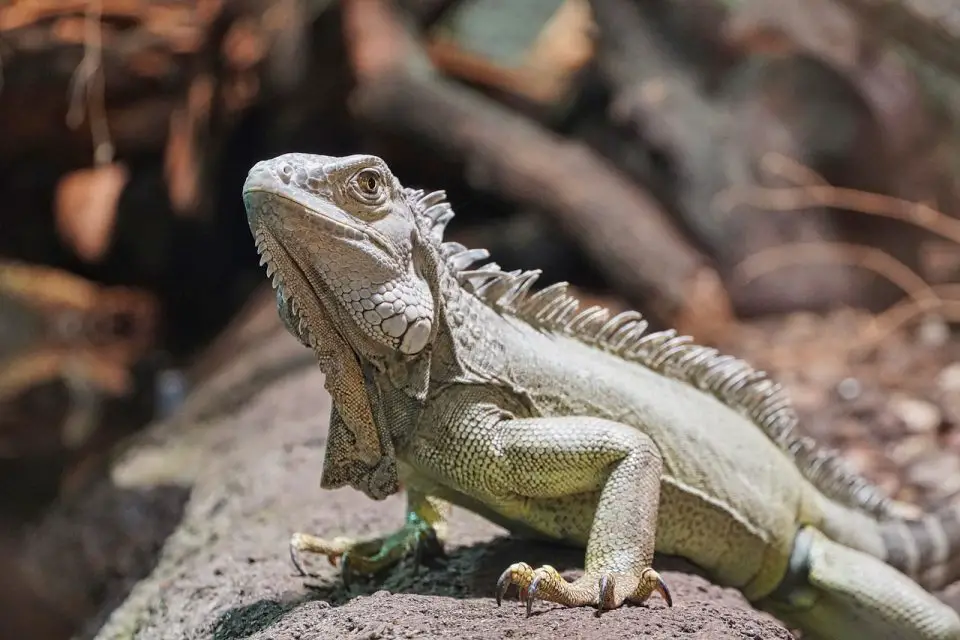One of the first things you may want to consider when choosing a pet is their average lifespan. After all, owning a pet is a commitment, and animals with longer lifespans are a bigger commitment.
Some reptiles, such as the tortoise, can live up to 150 years, which may leave you wondering how long the bearded dragon you are considering will live.
While your bearded dragon won’t live to be over 100, there are many factors that determine how long he or she will live.
What Factors Determine Lifespan?
A variety of different factors influence not only the length of your bearded dragon’s life but also the quality.
Keep reading to learn more about what affects exactly how long your bearded dragon lives.
Diet
What your bearded dragon eats each and every day will have a big effect on how long they will live.
Bearded dragons have a complex diet that requires a variety of different nutrients in order for them to live a long, healthy life.
The type of diet your bearded dragon needs, as well as the best way to feed them, will be discussed further below.
Environment
Other than diet, this is the second important factor of your bearded dragon’s health and wellbeing, and it includes things such as temperature and lighting.
In the wild, bearded dragons live in arid deserts where it is warm.
The best way to help them live a healthy life is by replicating these conditions to the best of your ability. The proper substrate, lighting, and temperature will be discussed further below.
Bearded dragons also need plenty of space. This allows them to not only grow but move around and get the exercise they need to improve and maintain their health.
Captivity
It’s no surprise that bearded dragons that live in captivity will live longer than bearded dragons in the wild.
Wild bearded dragons are vulnerable to many things – from exposure to the elements, territorial rivals, illness, injuries, and predators – that domesticated bearded dragons don’t have to worry about.
Bearded dragons that live in captivity also have constant access to the things they need to survive and live a healthy life – a proper diet, healthcare when needed, and a proper enclosure with the right conditions.
Breeding
Breeding places a lot of wear and tear on a female’s body, and breeding your female bearded dragon can actually reduce her lifespan. When possible, it is best to avoid breeding.
Isolation
Bearded dragons, in the wild, don’t live in groups. They are actually pretty solitary animals that can be extremely territorial and competitive for resources.
If you house more than one bearded dragon in an enclosure, you pose a risk for rivalries, especially if you are housing two male bearded dragons.
This can lead to fighting, which can lead to injuries in your bearded dragon, or resource hoarding which leads to a lack of proper nutrition.
Both of these can harm your bearded dragon’s overall health and wellbeing and lead to a shortened lifespan.
This means that the best way to help your bearded dragon live as long as possible is to not house them with other bearded dragons and instead isolate them to their own enclosures.
This will keep them safe and allow them to consume the resources they need, thus lengthening their natural lifespan.
Sex

Even if you aren’t breeding your female bearded dragon, she may still have a shorter lifespan than her male counterpart, which is opposite to humans.
Even if she is infertile, a female bearded dragon may lay a clutch of infertile eggs.
Species
Believe or not, but there are actually different species of bearded dragons, and each species has its differences. A good rule of thumb for bearded dragon species and their respective lifespan is that size matters.
Smaller bearded dragons species will have a shorter lifespan than bigger bearded dragon species. However, larger bearded dragon species will also need more resources and space in order to reach this extended life span.
How to Properly Care for Your Bearded Dragon to Ensure a Healthy Lifespan
In order for your bearded dragon to reach their full potential and live as long of a natural life as possible, it’s important that you do everything you can to provide the right care for them.
Two of the main things that you should focus on when caring for your bearded dragon are their diet and their environment.
Diet
In the wild, bearded dragons eat a diet of 75 percent protein and 25 percent fruits and vegetables.
However, this is because, in the wild, between hunting and roaming, bearded dragons get a dramatically larger amount of exercise than your captive bearded dragon.
Your bearded dragon will need much less meat than their wild ancestors, and, as they age, this amount will decrease even more.
Your bearded dragon will also need much more fruits and vegetables, which you start making constantly available for them at an early age to prevent raising a picky eater.
How to Feed Your Bearded Dragon Insects
Bearded dragons get their protein in the form of insects.
To feed insects to your bearded dragon, place live insects into their enclosure and allow them to eat as many insects as they desire within a 15 minute period.
Once 15 minutes have passed, if there are any uneaten bugs remaining in the enclosure, collect them. You can save these insects for a later feeding, so don’t worry.
However, it is necessary that you do take this extra step and time to remove live insects left after a feeding from the enclosure. Otherwise, if you do not, your bearded dragon could over eat.
Or, the insects could burrow in your bearded dragon’s substrate and lead to bigger issues, such as infestations, in the future.
Now, bearded dragons don’t tend to be picky when it comes to eating insects. In fact, they’ll eat nearly any creepy crawly that passes in front of them. However, you shouldn’t let them do that.
First, your bearded dragon should never eat insects that you have collected yourself. Wild insects, whether you find them outside or inside, can harm your bearded dragon.
Since you do not know where they have been or what they have eaten, it’s quite possible that wild insects have come into contact and ingested chemicals such as pesticides.
These can build up in your bearded dragon’s system and cause bodily harm.
You should also avoid insects that glow, such as fireflies, or insects that are poisonous or venomous, such as wasps nor should they eat scorpions
These creepy crawlies can either harm your bearded dragon while he or she is hunting, or, upon ingestion, could cause harm due to their bioluminescence or natural poison.
What to Feed Your Bearded Dragon
Only feed your bearded dragon insects that come from a feeder insect supplier. Here are some of the best insects to feed to your bearded dragon:
- Crickets
- Kingworms
- Waxworms
- Earthworms
- Cockroaches
- Locusts
- Butterworms
- Silkworms
- Phoenix worms
- Crickets
- Dubia roaches
- Mealworms*
- Superworms*
*Both mealworms and superworms should only be fed to adult bearded dragons.
Mealworms and superworms, which are a larger form of mealworms, contain a tough outer shell that, if not consumed properly, can cause gut impaction.
A major part of your bearded dragon’s diet should consist of fruits and vegetables. It’s best to feed your bearded dragon fresh produce, as frozen or cooked loses a large amount of its nutritional value.
With tougher fruits and vegetables that have to be cooked before being fed to your beardie, make sure that you allow it to cool to room temperature so as not to burn your bearded dragon.
Here are some of the best fruits and vegetables to feed to your bearded dragon:
 Figs
Figs- Melon
- Dates
- Peaches
- Apricots
- Plums
- Strawberries
- Guava
- Pears
- Grapes
- Raisins
- Peas
- Green beans
- Butternut squash
- Dandelion greens
Environment
Substrate
Substrate is what lines the bottom of your bearded dragon’s enclosure.
While most substrates are created equal, to lengthen your bearded dragon’s lifestyle, you should avoid using sands as a substrate, especially with baby and juvenile bearded dragons.
Younger bearded dragons are clumsy hunters, and, when hunting insects, they may ingest some of their substrate.
Sand is not digestible and will build up in your bearded dragon’s intestinal tract, leading to gut impaction, which can be fatal.
Reptile liners and carpets as well as newspapers are the most recommended substrates for bearded dragons of all ages.
Lighting
Lighting is one of the most important factors in making sure your bearded dragon lives as long of a natural life as possible.
Bearded dragons require a certain spectrum of light, known as ultraviolet, which is not visible to the human eye.
Actually, all animals, including humans need this type of lighting, and bearded dragons need high amounts of both UVA and UVB rays, especially the latter.
UVA and UVB can be found in sunlight, but it cannot pass through windows. While you can use a full spectrum light as a secondary source, it’s not nearly as good as the sun.
You’re probably wondering if making sure your bearded dragon gets enough UVB rays is really necessary considering how difficult it can be to make sure they have enough.
Well, without the proper lighting, your bearded dragon can die.
You see, UVB reacts with your bearded dragon’s cells and encourages them to produce Vitamin D.
Vitamin D is used during digestion to help with the absorption of calcium, which provides strong, healthy bones and other bodily processes such as waste removal.
Without enough calcium, a condition called hypocalcemia, your bearded dragon will begin to break down and reabsorb their bones.
A white light and an opened window are the best ways to get your bearded dragon the lightning they need, but you can also allow your bearded dragon outside with the right temperature and enough supervision.
Temperature
Bearded dragons are cold-blooded – the official term for this is actually ectotherm – which means that they cannot regulate their own body temperature and will need to absorb heat for an external source.
During the day, you’ll want to keep your bearded dragon’s enclosure at a temperature of at least 78 degrees to no more than 88 degrees (in Fahrenheit). During the night, you can allow it to drop a degree or two cooler.
Your bearded dragon will also want a temperature gradient. By having different parts of the enclosure at different temperatures, your bearded dragon will be able to find an area and temperature that is most comfortable for them.
Temperature is important as it affects your bearded dragon’s metabolic processes.
If the temperature is too cold, your bearded dragon will be lethargic and struggle to digest food. If it is too warm, your bearded dragon will be uncomfortable and reject food in an attempt to escape.
How Long Do Bearded Dragons Live?
Now since you know everything about providing the proper care for your bearded dragon, as well as what factors affect their maximum age, we can finally answer the question of how long do bearded dragons live.
In the wild, or in captivity with minimum or poor care, bearded dragons will live up to a maximum of eight years. With proper care, this number can increase to twelve years.
The average maximum for captive bearded dragons with above excellent care is fourteen years, though there have been some cases – though unconfirmed – of bearded dragons living to a maximum of nineteen years.
Final Thoughts: How Long Do Bearded Dragons Live?
 Bearded dragons, with the proper care, have a fairly long lifespan. This means that adopting one is a big commitment that you need to think wisely on after doing a large amount of proper research.
Bearded dragons, with the proper care, have a fairly long lifespan. This means that adopting one is a big commitment that you need to think wisely on after doing a large amount of proper research.
As beginner pets, they are relatively low maintenance, but they do still require regular care in order to live their best lives.
This includes making sure they have a proper diet and enclosure that includes the right temperature, substrate, and lighting to fit their lifestyle and needs.
However, bearded dragons are curious, interesting creatures who make great companions, and adopting one is sure to be a fun and eye-opening experience!
